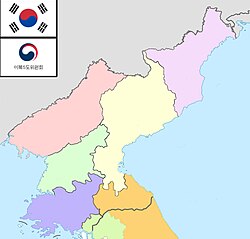Committee for the Five Northern Korean Provinces
Committee for the Five Northern Korean Provinces 이북오도위원회 / 以北五道委員會 | |
|---|---|
 Map of North Korea with provincial divisions claimed by South Korea | |
| Official languages | Korean |
| Government | Government body under the Ministry of Security and Public Administration |
• Governor | Han Sang-sun (Hwanghae Province) Baek Gu-Seop (North Pyeongan Province) Baek Nam Jin (South Pyeongan Province) Park Ki-jeong (North Hamgyeong Province) Hwang Deok-ho (South Hamgyeong Province) |
| Local government under the Republic of Korea | |
| ISO 3166 code | KP |
| Committee for the Five Northern Korean Provinces | |
| Hangul | 이북5도위원회 |
|---|---|
| Hanja | 以北五道委員會 |
| Revised Romanization | Ibuk Odo Wiwonhoe |
| McCune–Reischauer | Ibuk Odo Wiwŏnhoe |

The Committee for the Five Northern Korean Provinces (Korean: 이북5도위원회; Hanja: 以北五道委員會, literally "The North's Five Provinces Committee") is a South Korean government body under the Ministry of Security and Public Administration.
History[]
Established in 1949, the committee is officially responsible for the administration of the five Korean provinces located entirely north of the Military Demarcation Line, as the South Korean government formally claims to be the sole legitimate government of whole of Korea. The South Korean government does not recognise any changes to the borders of the provinces made by North Korea since its establishment. The President of South Korea appoints governors for each of the five provinces.[1] However, their role is largely symbolic (compare with titular bishops), as the territory is under the effective jurisdiction of North Korea. The committee's main practical function is to provide support to North Korean defectors living in South Korea, including helping with the resettlement of North Koreans and organizing social events for North Koreans.[1][2]
Despite its name, the committee plays no part in North Korea–South Korea relations; North Korean affairs are handled by the Ministry of Unification.[1] In the event of a North Korean collapse, contingency plans call for a new government body to be set up to administer the North under the leadership of the Unification Minister. In that case, the five governors would have to resign and the committee would be disbanded.[1][3]
Flags of the five northern Korean provinces[]

North Hamgyeong

South Hamgyeong

Hwanghae

North Pyeongan

South Pyeongan
Southern provinces with territory in North Korea[]
Two South Korean provinces, Gyeonggi and Gangwon, officially have parts of their territory in North Korea. The South Korean government considers the governors of these two provinces the head of their entire province, including the parts in the North.[3]
- Gyeonggi Province - Gaeseong, Gaepung County & Jangdan County claimed
- Gangwon Province - from Kangwon province - Gimhwa County, Icheon County, Tongcheon County, Pyeonggang County and Hoeyang County claimed
See also[]
References[]
- ^ Jump up to: a b c d "South Korea's Governors of Northern Provinces Don't—And Never Will—Govern". The Wall Street Journal. March 17, 2014. Archived from the original on 2014-12-15. Retrieved 2 April 2014.
- ^ "Purpose/Function". The Committee for the Five Northern Korean Provinces. Archived from the original on 7 April 2014. Retrieved 2 April 2014.
- ^ Jump up to: a b "South Korea's Governors-in-Theory for North Korea". The Wall Street Journal. March 18, 2014. Retrieved 29 April 2014.
External links[]
- Government agencies of South Korea
- Local government in South Korea
- Korean irredentism
- Governments in exile
- States and territories established in 1949







